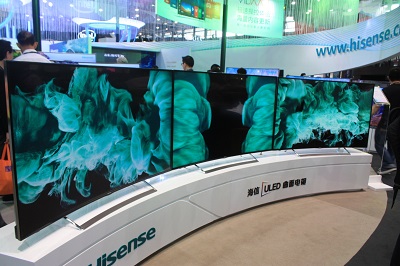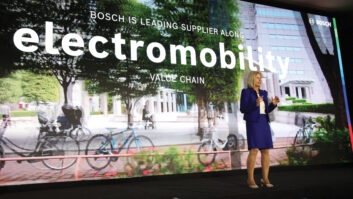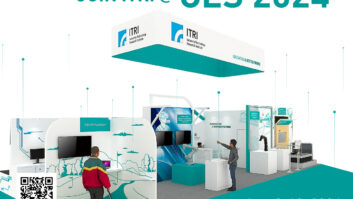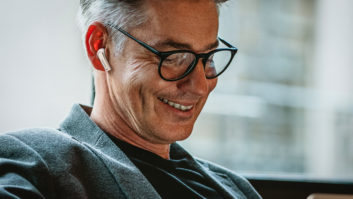
SHANGHAI, CHINA — The inaugural CES Asia drew a larger-than-expected crowd of close to 25,000 attendees, 1,000 members of the international press and more than 250 exhibitors from 16 countries, according to Consumer Electronics Association president/CEO Gary Shapiro.
The event drew a mostly Chinese crowd, though a third of the attendees were from other countries, Shapiro said.
The scaled-down version of International CES featured speakers representing the breadth of the global consumer technology sphere, many of whom catered their addresses to emphasize the importance and influence of the Asian Pacific market.
Audi chairman Rupert Stadler kicked of the proceedings Sunday evening with a ringing endorsement of the digitization of technology. His premise, that the digital revolution is having a stronger and much faster impact on global business and the human condition than the original industrial revolution, was endorsed by subsequent speakers throughout the week.
Stadler spoke of the ways today’s smart technologies are altering almost every industry, and specifically cited how digital workflows, 3D printing, robotics and virtual reality are changing the way cars are designed, manufactured and sold.
Looking ahead, Stadler espoused the virtues of the coming revolution of driverless cars, citing that 90 percent of the 1.1 million death per year by car accident are caused by human error. “Pilotless driving has the potential to be much safer. It will save lives,” he said.
Stadler’s big finish was the world debut of Audi’s pilotless R8 coupe, and he invited (dared?) those in attendance to drop by Audi’s booth and sign up for an 8-kilometer test-ride through Shanghai’s notoriously trafficky downtown.
Intel senior VP Kirk Skaugen’s keynote sketched out a strategy to change the most basic ways users interact with technology to better their lives.
Skaugen stressed the promise of future technology, driven by innovative Intel computing power solutions, that will eliminate everyday computing realities like the mouse and keyboard, cables and passwords, among others.
IBM’s D.C. Chen, who heads the company’s Greater China group, focused his keynote on the potential of the Internet of Things and especially the tremendous potential for the use of big data to solve real-world problems facing businesses, such as the weather’s impact on shipping, for example.
Scott Burnett, IBM’s global director of CE, followed that up with a three-point plan for the use of data by businesses to accelerate innovation, enhance operations and improve engagement with customers. Sadly, he said, much of the data being collected by IoT devices currently is not being captured or analyzed in real time, which renders much of it useless. But, he said, that will change. “We are in the first inning of a nine-inning ball game with the IoT,” he said, and stressed the role that the “data scientist” will have on the future of business, health and the lives of everyone on the globe.
Kicking off a series of addresses by “industry movers,” Twitter VP Shailesh Rao declared that the “global conversation” that is enabled by Twitter in particular, and social media in general, is already breaking down the walls of communication between world leaders and their constituents, entertainers and their fans, and most importantly in the context of CES Asia, businesses and their customers.
Rao stressed the importance of communication that is live, public, conversational and instantly distributed. Such conversation, which spikes around the world during significant events such as the World Cup, international elections and tragedies, allows a global audience to weigh in and raise discourse and dialogue.
Rao pointed out that this type of communication is still in its infancy, and its potential to change the world is a matter of when, not if.
One person who was clearly pleased with the way the show unfolded was CEA’s Shapiro, who hosted an intimate Q&A for select members of the press.
Shapiro added context to the scale of the event, explaining that companies had to be approved by CEA to buy exhibition space by proving their technology was viable, unique, legal and didn’t violate any intellectual property rules.
Of the 20,000 gross square meters of exhibition space, a third of the companies were from China and the rest were from 16 other countries.
Shapiro noted the amount of exhibition space exceeded that of the first Consumer Electronics Show in New York City in 1967.
Exhibition space was also limited to 14 core technology categories, representing growth sectors of the industry. The 14 were 3D printing, automotive, content and online, green technologies, health, home entertainment, lifestyle, mobile, robotics, smart home, sports and fitness, video/4K Ultra HD, video gaming and wearables.
It was evident from walking the show floor that wearables was the dominant technology being displayed and Shapiro confirmed that 20 percent of the exhibitors were displaying a wearables product or technology.
Eleven major car companies were in attendance and smart-home products were also prevalent.
Shapiro confirmed that CES Asia 2016 is a go, taking place May 11-13, 2016, at the same location.
He added that based on space renewals alone and discussions with the CEOs of some major companies that were not exhibiting at this year’s event, CEA expects to expand the exhibition space into at least one more hall of the massive Shanghai New International Expo Center complex next year.













